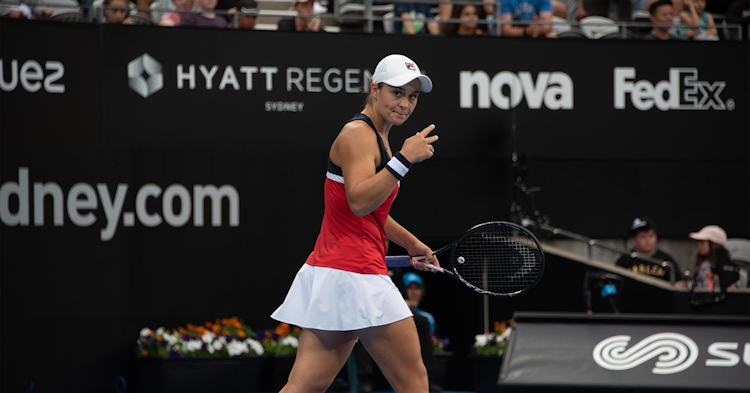Ash Barty and the Reality of Cycles
Last updated: Nov 4, 2019, 8:13AM | Published: Nov 4, 2019, 8:04AM
This image is a derivative of Sydney International Tennis WTA Premier Sydney,
by Rob Keating (CC BY-SA 2.0)
Ash Barty knows about the cycles of life. She knows what it means to invest herself in a sport. She also knows what it means, and feels like, to need a change of pace.
Remember this part of Ash Barty’s backstory as she celebrates a WTA Finals championship in Shenzhen, China: She left tennis for cricket, and then came back.
This is not a common path, but it was and is Barty’s path.
She didn’t pursue cricket with the intention of building a World No. 1 tennis career and making history in Australian sports on a massive scale.
She didn’t play cricket as part of a grand plan for tennis. She explored cricket as a young athlete. She learned about herself. She then wanted to go back to tennis. It is as simple as that.
Tennis players don’t follow the specific path Ash Barty followed. They do, however, know what every athlete feels: the strain of going to work every day, which generally involves an encounter with the joys and burdens of competition.
Some days feel like joys, other days feel like chores. Sunshine and shadow. Clarity and confusion… even for the legends and icons among us.
The Big 3 – Novak Djokovic, Rafael Nadal, Roger Federer – and Serena Williams haven’t just spoiled most tennis fans and observers. They have, more specifically, distorted reasonable expectations for tennis players in various contexts.
The Big 3 and Serena (in this era) have played many tournaments in which they lost in the semifinals or final, and the result FELT to many fans like a crushing disappointment, even if their performance in a tournament was objectively great. That is simply a product of winning truckloads of big titles. Once that insanely high standard is established, anything short of it naturally feels like a letdown.
Everyone who closely follows the sport of tennis has an opinion on what a player with a certain level of credentials should achieve.
A 15-time major champion should achieve at this level. A five-time major champion should achieve at that level. A top-five player should do this. A top-20 player should do that.
<ad>
Few tennis players receive more scrutiny, and are burdened with larger expectations, than World No. 1 players. How can we know this is true? Consider all the times a World No. 1 player who has not won a major (Marcelo Rios being an example in men’s tennis from two decades ago) received a tsunami of criticism for supposedly “diminishing” or “devaluing” the prestige of a No. 1 ranking.
When Caroline Wozniacki, at the beginning of this decade, became No. 1, she endured withering criticism precisely because she didn’t win a major. Only when she broke through in 2018 at the Australian Open did she slay that demon.
Karolina Pliskova was World No. 1 for a brief time in 2017. She acquired that ranking without a major title. She was instantly diminished for having the nerve to claim the No. 1 ranking without having a major championship. This is par for the course. It isn’t particularly fair, but it’s real.
Ash Barty won Roland Garros and THEN became World No. 1, so she never had to endure the “World No. 1 without a major” label. However, becoming the new World No. 1 still invites intense skepticism. The highly improbable nature of her Roland Garros title (clay is the last surface on which anyone figured Barty would win her first major) certainly led some commentators and fans to question whether this World No. 1 player – even with a major trophy – would hold up under pressure.
The summer, which contained plenty of struggles, seemed to validate the skeptics.
Yet, after the autumn portion of the 2019 season – with a Beijing final and now the WTA Finals championship in Shenzhen, completed with a win in the final match against Elina Svitolina – Barty has offered an authoritative response to those doubts.
What does this prove?
No, it doesn’t prove that Barty’s skeptics are full of bunk. I’m not going to make a sweeping and forceful condemnation of anyone who doubted that Barty could carry the weight of a World No. 1 player.
What Barty’s autumn resurgence proves is merely that tennis players go through cycles of ups and downs.
And? What else?
And this: That the cycles endured by top-tier women’s tennis players today bear very little – if any – resemblance to the cycles of the iconic World No. 1 players we remember from past decades.
Chris Evert. Martina Navratilova. Steffi Graf. Monica Seles. Venus and then Serena Williams. The WTA has had its share of Wozniackis and Pliskovas, but the biggest names in the sport over the past 40 years have indeed reigned at No. 1 for long periods of time.
We who follow and study women’s tennis should not think that a bad cycle – a bad two- or three-month portion of a season – represents proof of a player failing to live up to expectations or carry the weight of pressure.
<ad>
The modern WTA – the 2019 WTA, the WTA which has existed since Serena Williams became a mother – has been defined by the volatility and unpredictability of the tour. There has been a lack of continuity from one season or surface to the next.
Remember the big story of 2019 WTA tennis, transcending any individual player: 12 women made major semifinals; only two (Serena and Svitolina) made two major semifinals this past year.
When we realize that fact and absorb its meaning, we are brought to this larger epiphany: NO ONE is producing dominance over the course of a full women’s tennis season.
It’s not just Barty. It’s everyone.
Naomi Osaka didn’t take over the tour this year. Bianca Andreescu might have been the most dominant player when she actually played, but she played on only one surface (plus one match on clay at Roland Garros). She played only 60 percent of the season.
Any top player who played a full season went through cycles of good and bad. No elite player was relentlessly great – not Barty, not Osaka, not Pliskova, not Simona Halep, not Petra Kvitova, not Belinda Bencic, not Svitolina, not Kiki Bertens, not Serena.
The present-day WTA is a tour defined by cycles, by ups and downs. No. 1 players won’t win two majors and reach four major semifinals and win five or more titles all in the same year.
Consider the player who was the 2017 and 2018 year-end World No. 1, before Barty earned that honor in 2019: Simona Halep.
In 2017 and 2018, Halep did not destroy the field. She made the Roland Garros final in 2017 and won it in 2018, also reaching the 2018 Australian Open final. She was clearly the most consistent WTA player through the first eight months of 2018, but ran out of steam at the U.S. Open and did nothing more in the remainder of the year, having been worn down by injury.
Halep won three titles in 2018. She reached a large number of semifinals, but closed the door at only three tournaments. It wasn’t a bad year for a World No. 1. Yes, it lacked the number of titles a World No. 1 would ideally like to have. However, it did keep Halep on the top of the mountain as the year-end No. 1 for 2018.
Why is that? Because the season was better than any of Halep’s peers.
Instead of applying a flat set of fixed expectations to players as I mentioned above (a 15-time major champ should achieve X, a five-time major champ should achieve Y), we need to appreciate and evaluate players within the context of the rest of the tour.
If anyone doubted Ash Barty’s ability to live up to the billing as World No. 1, let’s remember that Barty isn’t playing in a vacuum; she is playing against the rest of a tour which exists in the same boat.
If Barty goes through cycles of success and failures, her peers are going through the same things… and as this Shenzhen WTA Finals championship showed, Barty is clearly enduring the ups and downs of life on tour better than her foremost competitors.
If you think Ash Barty or any World No. 1 player must dominate the tour in order to be worthy of the top ranking, let me tell you something very simple: Stop doing that. Recalibrate your expectations. Realize that Barty will go through rough periods… and allow that others will do the same.
Barty isn’t competing against a set of standards etched in stone or written on a blackboard; she is competing against other women’s tennis players… all of whom didn’t have as good a 2019 season as Ash Barty did.
Did you enjoy this article? Leave a comment below, or join the conversation on the Stats Insider Twitter or Facebook page.



